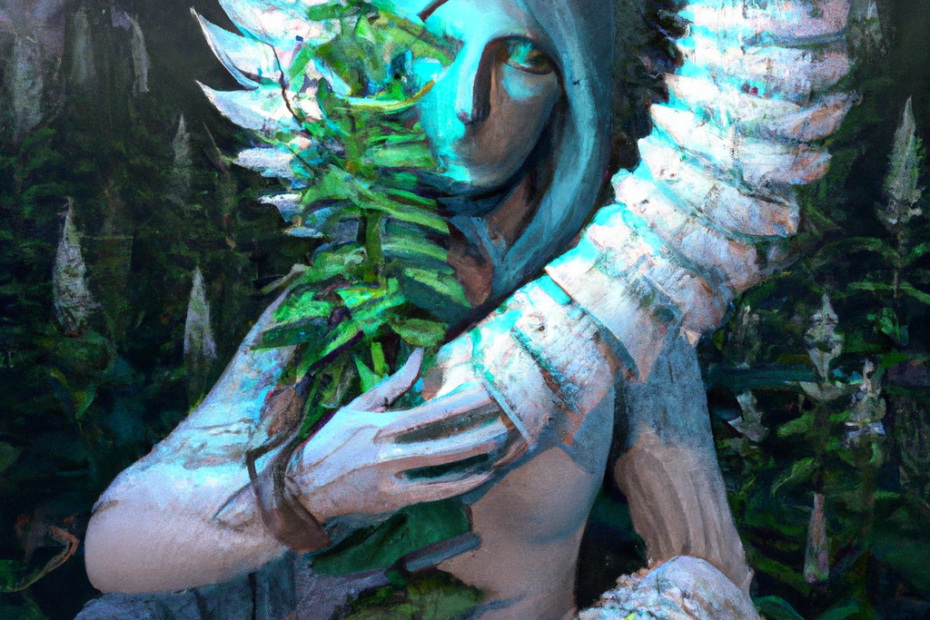Salvia Divinorum, often referred to as simply “Salvia,” is a powerful and unique plant known for its psychoactive properties. Whether you are a seasoned gardener or a novice enthusiast, cultivating Salvia Divinorum can be a rewarding and enriching experience.
In this comprehensive guide, we will delve into the practical tips and techniques for successful Salvia Divinorum cultivation. From choosing the right location and preparing the soil to harvesting and storing the plant, we will cover every aspect of the cultivation process. We will explore common mistakes to avoid and the telltale signs of a healthy Salvia Divinorum plant.
Whether you are looking to expand your botanical repertoire or simply curious about the intricacies of cultivating this fascinating plant, this guide is an indispensable resource for anyone interested in Salvia Divinorum cultivation. So, let’s embark on this horticultural journey and unlock the secrets to thriving Salvia Divinorum plants.
What Is Salvia Divinorum?
Salvia Divinorum, also known as Diviner’s Sage, is a psychoactive herb belonging to the mint family, native to the cloud forests of Mexico.
Used traditionally by Mazatec shamans for spiritual healing and divination, this intriguing plant is characterized by its unique psychoactive compound, salvinorin A, which induces intense hallucinogenic experiences when ingested or smoked. Despite its recreational use, Salvia Divinorum has shown potential for medicinal applications, particularly in treating depression, anxiety, and addiction due to its effects on mood and perception regulation. The plant’s psychoactive properties have drawn scientific interest, prompting studies to explore its mechanisms of action and therapeutic potential.
How to Cultivate Salvia Divinorum?
Cultivating Salvia Divinorum requires attention to specific techniques and care to ensure successful growth and maintenance of this unique herb.
Choosing the Right Location
Selecting the right location for Salvia Divinorum cultivation is crucial, considering factors such as environmental conditions and suitability for both indoor and outdoor growth.
It’s essential to create a stable environment that mimics the plant’s natural habitat, whether it’s indoors or outdoors. Indoor cultivation offers control over temperature, humidity, and light exposure, allowing for year-round growth. On the other hand, outdoor cultivation harnesses natural sunlight and airflow, promoting the plant’s optimal development. Ensuring the chosen location provides adequate space, protection from extreme weather, and the right soil composition will significantly influence the success of Salvia Divinorum cultivation.
Both indoor and outdoor settings have distinct advantages, and the decision should align with the specific needs of the plant and the grower’s preferences.
Preparing the Soil
Preparing the soil for Salvia Divinorum cultivation involves potting the plant in nutrient-rich soil, ensuring optimal conditions for growth and nutrient uptake.
The potting process is crucial, requiring a well-draining soil mix to prevent waterlogging, as Salvia Divinorum dislikes soggy conditions. A balanced soil mix with peat moss, perlite, and organic compost enhances aeration and water retention. Adding organic fertilizer with micronutrients such as phosphorus and potassium supports robust growth. The soil pH should be slightly acidic, ideally between 6.0 and 6.5, promoting nutrient availability. Nutrient-rich soil promotes healthy root development, ultimately contributing to the successful cultivation of Salvia Divinorum.
Selecting and Planting the Seeds
The selection and planting of Salvia Divinorum seeds marks the initial stages of propagation, setting the foundation for healthy growth and plant development.
Proper seed selection is crucial as it determines the genetic traits and overall health of the plants. When choosing seeds, it’s important to seek reputable sources to ensure high-quality genetics. Understanding the planting techniques such as the depth of sowing, soil conditions, and the right amount of moisture is essential for successful germination. Once planted, the seeds are expected to germinate within a specific timeframe, typically within a few weeks, signaling the beginning of the plant’s growth journey.
Providing Proper Care and Maintenance
Proper care and maintenance form the cornerstone of successful Salvia Divinorum cultivation, encompassing aspects such as watering, lighting, and fertilizing to ensure optimal growth.
Watering practices are crucial as Salvia Divinorum thrives in moist but well-drained soil, making it important to water the plant regularly without allowing the soil to become waterlogged. When it comes to lighting requirements, this plant prefers indirect sunlight or partial shade. Fertilization techniques should involve using a balanced, water-soluble fertilizer during the growing season, promoting healthy growth. These elements, when carefully managed, ensure the flourishing cultivation of Salvia Divinorum.
What Are the Common Mistakes in Salvia Divinorum Cultivation?
Despite its resilient nature, Salvia Divinorum cultivation is prone to common mistakes that can jeopardize the plant’s growth, including issues related to watering, lighting, and nutrient provision.
Overwatering
Overwatering poses a significant risk to Salvia Divinorum cultivation, potentially leading to root rot and hindered growth due to excessive water presence in the soil.
This can result in reduced oxygen availability for the roots, leading to their gradual decay and compromising the plant’s overall health. The constant moisture can create a favorable environment for fungal and bacterial diseases, further deteriorating the plant’s condition.
The consequences of overwatering also extend to nutrient imbalances and poor water uptake, affecting the plant’s vigor and ability to withstand environmental stressors. It’s crucial to maintain a balanced watering schedule to support the optimal growth and development of Salvia Divinorum.
Underwatering
Inadequate watering or underwatering can detrimentally affect Salvia Divinorum growth, leading to wilting, leaf damage, and overall stress on the plant due to water deprivation.
This lack of water can disrupt the plant’s metabolic processes, reducing its ability to photosynthesize and produce energy, which in turn stunts its growth and diminishes its overall health. Underwatering can lead to increased susceptibility to pests and diseases, as the weakened plant becomes more vulnerable. It’s crucial to maintain proper moisture levels to ensure that Salvia Divinorum thrives and remains resilient, enabling it to withstand environmental challenges and promote optimal development.
Improper Lighting
Improper lighting conditions present a potential risk to Salvia Divinorum cultivation, impacting the plant’s photosynthesis, growth patterns, and overall vigor due to inadequate or excessive light exposure.
Light plays a crucial role in the process of photosynthesis, where the plant converts light energy into chemical energy. Inadequate light can lead to stunted growth, pale or yellowing leaves, and reduced yield. On the other hand, excessive light exposure can cause sunburn, chlorophyll damage, and in severe cases, inhibit the plant’s ability to produce energy.
Striking a balance and providing the appropriate intensity and duration of light is crucial for the health and proper development of Salvia Divinorum plants.
Lack of Nutrients
A deficiency in essential nutrients poses a significant risk to Salvia Divinorum cultivation, potentially leading to stunted growth, nutrient deficiencies, and overall plant stress due to inadequate nourishment.
This can result in reduced nutrient uptake, which further exacerbates the plant’s susceptibility to pests and diseases. Inadequate nutrition can impact the plant’s ability to produce essential compounds, such as salvinorin A, affecting not only the plant’s health but also its psychoactive properties.
To prevent these consequences, it’s crucial for cultivators to closely monitor and maintain the proper balance of nutrients in the Salvia Divinorum cultivation environment, ensuring optimal growth and overall plant vigor.
What Are the Signs of a Healthy Salvia Divinorum Plant?
Recognizing the signs of a healthy Salvia Divinorum plant involves assessing vibrant leaves, robust stems, and the absence of pests or diseases, indicating optimal growth and vitality.
Vibrant Green Leaves
Vibrant green leaves are a key indicator of a healthy Salvia Divinorum plant, signifying robust growth, optimal nutrient uptake, and overall well-being.
The lush green color of the leaves speaks to the plant’s ability to photosynthesize effectively, converting sunlight into energy. This vitality in the foliage is crucial for the plant’s ability to produce the psychoactive compounds it’s renowned for.
The visual cues of vibrant green leaves provide important feedback for growers, indicating that the plant is receiving the right balance of water, nutrients, and light. As such, their significance in assessing the health and growth of the Salvia Divinorum cannot be overlooked, making them an essential aspect of cultivation practices.
Strong and Sturdy Stems
“Strong and sturdy stems are indicative of a healthy Salvia Divinorum plant, reflecting robust structural integrity, successful cultivation, and optimal growth conditions.”
“These vital plant structures are integral to supporting the vigorous development of the Salvia Divinorum. They not only provide stability for the overall plant structure but also play a crucial role in nutrient transport, water uptake, and the ability to withstand environmental stressors. Sturdy stems contribute to the plant’s resistance to diseases and pests, ensuring its long-term viability. Evaluating and nurturing strong stems is, therefore, essential for the successful cultivation and thriving growth of Salvia Divinorum.”
No Signs of Pests or Diseases
The absence of pests or diseases is crucial for assessing the health and vitality of Salvia Divinorum, necessitating vigilant monitoring and proactive measures to maintain a pest-free and disease-resistant environment.
This is particularly important as pests and diseases can significantly impact the overall well-being of the Salvia Divinorum plant, leading to stunted growth, reduced yield, and even potential loss of the entire crop. By implementing thorough monitoring strategies and proactive pest control measures, cultivators can ensure that the plant remains free from harmful organisms. Maintaining disease-free conditions is essential not only for the current crop but also for preventing the spread of diseases to future generations of Salvia Divinorum plants.
How to Harvest and Store Salvia Divinorum?
The process of harvesting and storing Salvia Divinorum involves careful timing and methods to preserve the plant’s potency and prepare it for future use.
When to Harvest
Determining the right time to harvest Salvia Divinorum is essential for preserving the plant’s potency and maximizing its psychoactive and medicinal attributes, necessitating careful consideration of cultivation timelines and growth stages.
The potency of Salvia Divinorum is closely tied to its growth stages, with the highest levels of salvinorin A, the plant’s active compound, typically found in the pre-flowering stage. It’s important to monitor the plant’s development and wait for the appearance of fresh leaves before harvesting. By harvesting at this stage, cultivators can ensure optimal potency. Environmental factors such as humidity, temperature, and light exposure also play a crucial role, and professional growers often employ specific techniques to cultivate the plant to maximize its psychoactive properties.
How to Properly Harvest
Properly harvesting Salvia Divinorum involves employing specific techniques to preserve the plant’s psychoactive properties, ensuring effective preservation and long-term usability.
By carefully timing the harvesting process, growers can maximize the concentration of the plant’s active compounds. It is important to harvest the leaves at the peak of their potency, typically before the flowering stage. Utilizing gentle handling methods and proper drying techniques helps to maintain the plant’s psychoactive attributes.
After harvesting, proper storage in a cool, dark place is essential to prevent degradation of the plant’s potency. These meticulous practices not only ensure the preservation of Salvia Divinorum‘s psychoactive properties but also contribute to the sustainability of its cultivation.
Storing for Future Use
Storing harvested Salvia Divinorum for future use involves preservation methods to maintain potency and medicinal efficacy, ensuring the plant’s long-term usability and effectiveness.
This can be achieved through proper drying and storage techniques. Ensuring that the harvested leaves are thoroughly dried before storage is crucial as it prevents mold and degradation. Airtight containers, preferably glass jars, should be used to preserve the potency of the plant material. Storing the containers in a cool, dark place away from direct sunlight and moisture helps to retain the plant’s active compounds. Periodically checking the stored Salvia Divinorum for any signs of degradation and replenishing the storage environment as needed is essential for maintaining its long-term usability.”
Frequently Asked Questions
What is Salvia Divinorum and why is it important to cultivate successfully?
Salvia Divinorum is a medicinal and spiritual plant native to Mexico that has gained popularity for its psychoactive properties. It is important to cultivate it successfully to ensure a steady supply of this plant for personal use or for research purposes.
What are some practical tips for successful Salvia Divinorum cultivation?
– Start with healthy seeds or cuttings from a reputable source
– Use a well-draining potting mix and keep the soil moist but not soggy
– Provide ample sunlight or use grow lights for optimal growth
– Maintain a consistent temperature and humidity level
– Regularly fertilize with a balanced fertilizer
– Harvest the leaves carefully and sparingly to encourage regrowth
How long does it take for Salvia Divinorum to reach maturity?
Salvia Divinorum typically takes 1-2 years to reach maturity when grown from seeds. If using cuttings, it can take as little as 3-6 months to mature.
What is the best way to propagate Salvia Divinorum?
The best way to propagate Salvia Divinorum is through stem cuttings. Simply cut a healthy stem with a few leaves and place it in a glass of water until roots form. Once roots have developed, transplant the cutting into soil.
How can I ensure the potency of my Salvia Divinorum plants?
– Use proper lighting and temperature to mimic the natural habitat of Salvia Divinorum in the Sierra Mazateca region of Mexico
– Avoid over-fertilizing, as this can decrease potency
– Harvest leaves at the right time, when they are fully matured and before the plant starts to flower
Can Salvia Divinorum be grown indoors?
Yes, Salvia Divinorum can be grown successfully indoors as long as proper growing conditions are maintained. This includes adequate lighting, temperature, and humidity levels, as well as regular fertilization and pruning.
John Marston, a seasoned writer since 2009, has penned hundreds of articles on Salvia Divinorum across the web. As a full-time writer at a prominent online salvia retailer, he continues to contribute valuable insights, combining expertise and passion to unravel the diverse facets of Salvia Divinorum. Beyond his writing, John serves as a budtender in the cannabis industry.




